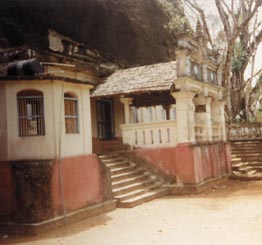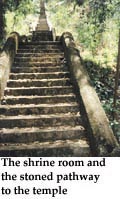
1st October 2000
News/Comment|
Editorial/Opinion| Business| Sports|
Sports Plus| Mirror Magazine

Cards: Saying it the local way
One of the simple delights in life is browsing through a card shop. You might not be searching for a particular card, but most often you end up having spent many pleasurable moments for with their attractive pictures and touching words, cards crystallize a wide range of emotions, and express feelings for which we on our own may sometimes not have words.A card shop, which gives you that satisfying card experience, is Uthum Publishing House, popularly known as 'Uthum Pathum'. It all started in 1982-on October 5- when husband and wife team, Mr. and Mrs. Peter Samuel decided it was time to remedy the lack of quality greeting cards in the local market. Their aim was a quality product and they also wanted to donate part of their profits to charity as well. Their first showroom was opened at Liberty Plaza 18 years ago and they now have eight showrooms and a wide dealer network.
"A card caters to the finer qualities of an individual, and our motto is 'Let's spread a little love'," said Mrs. Y. N. Samuel, addressing a news conference last week. She and her late husband started Uthum Pathum under licence from Gibsons, USA, and are now affiliated to Hallmark and Archies. Their market rapidly grew and down the years Uthum Pathum's productions were commended by greeting card giants like Hallmark and Gibsons, at exhibitions held abroad.
While spreading a little love, Uthum Pathum is also responsible for creating a card culture with a distinctly local flavour. Many of their cards are adorned with traditional scenes as well as the country's fauna and flora. Uthum Pathum's collection covers a divese array of emotions and occasions, and gift items are also available at their showrooms.
Keeping to their pledge of charity, Uthum Pathum last week donated a
wheelchair and two walkers to Helpage to mark their anniversary. They have
also planned a whole range of anniversary surprises for those who visit
any of the Uthum Pathum showrooms from October 5.
Funny Business
Think before you 'undress'
By Royston Ellis
"No topless or nude bathing," said the sign in the bathroom of a Maldives resort where my friend, a tea planter, stayed on holiday recently. He was a bit puzzled, but dutifully kept on his swimming trunks when he took a shower.Dress sense is important on a holiday. It sets the mood. Hawaiian shirts are colourful and sunny so not only the wearer but also the beholder feels bright and cheerful.
On holiday we should dress to please others as well as ourselves, although it seems few holiday-makers take that into consideration when they don their beach wear.
Men and women on holiday who have expanded from their slim, youthful beauty into middle-ageD obesity and sloppiness, do themselves no favours by trying to cram it all into skimpy bikinis.
When beach clothes, or lack of them, become accepted dress in public places, it is not only sensitive locals who will be offended, but other guests as well.
There is a resort in Sri Lanka that considers itself upmarket, and charges a room rate corresponding to its pretensions. I was appalled to see in its glossy brochure a photograph of guests in the hotel's restaurant wearing sleeveless vests.
It's bad enough to have to queue at a buffet to serve yourself for dinner, and then find a ten- percent service charge added to the bill (I think there should be a ten percent reduction for having to do all the waiting and serving yourself.
However, buffets become even worse if you have to gaze at the hairy armpits of fellow diners (women as well as men) as they reach for the salad dressing.
Dressing up is fun. Of course, I realise that those on holiday from their offices where they must always wear ties or formal frocks, relish casual clobber while on holiday. Casual is fine, as long as body parts don't flop out or dangle offensively over one's soup as half-naked guests pass one's table.
If you go on holiday on a cruise liner, dressing up is part of the routine. This doesn't mean men have to take along the suit they wear in the office all the year, or women to pack their favourite, but tired, dresses.
Cruising is an excuse to buy stylish clothes, to wear something different; to feel and look sensational. Where else could you wear a tuxedo or glamorous evening dress with such panache as at the Captain's cocktail party?
Alas, a holiday in a beach resort here seems to be an excuse for dressing down, instead of up.
Eating alfresco doesn't demand dirty jeans or a sleeveless top; it's a chance to display the latest tropical fashions, even those produced and sold right here.
Designer-label clothes are sold in Sri Lanka at third world prices; that is a third of what they cost overseas.
I am bemused, though, by the fashion that requires someone else's name to be on one's shirt, or trousers. I don't understand why I should have "Nike" across my breast, or "Levis" across my bottom. If anyone's name has to be on my clothes, I feel it should be my own. I have paid for my clothes so I don't see why I should have to sport an advertiser's logo, like a human billboard, unless I get paid for it.
Years ago at the Gucci store in Manhattan, a salesman confided to me that people came in with scissors and snipped off the buttons bearing the Gucci logo, so they could sew them on to their own, non-gucci clothes.
This embarrassed me somewhat as I had removed the Gucci buttons from a suede jacket I had bought, as I thought it was too vulgar.
Recently I have considered having a logo on my shirts, to compete with the advertising that everyone else wears.
Perhaps a slogan in Sinhala saying, "I am not a tourist so please charge the normal price" would be appropriate when I go to the market or hop a three wheeler.
After all, since what one wears sends a message to the world, let it
be a useful one.
Temple on the hill
By Major Chandana Weerakoon
 The
history of Kahandawa temple is inextricably linked with King Walagamba,
who during his battles with various Indian invaders had taken refuge on
the Kahandawa hill. Legend has it that he and his men lived in the huge
caves on the hill and later converted them to shrines.
The
history of Kahandawa temple is inextricably linked with King Walagamba,
who during his battles with various Indian invaders had taken refuge on
the Kahandawa hill. Legend has it that he and his men lived in the huge
caves on the hill and later converted them to shrines.
In some places traces of the thick walls built in ancient times, though mostly broken over the years, can still be seen. Monks around 100 B.C restored and began using the temple.
The village of Kahandawa in the Mirigama area can be reached by travelling about two miles on the Hakkurukbura road, which turns off from the Negombo Road.
 The
temple is unfortunately in a neglected state but the beauty of its surroundings,
set on a hilly slope is enchanting. Large numbers throng the temple on
Poya days, climbing the steps to the shrine room and no doubt admiring
the spectacular view of the countryside that can be had from the top.
The
temple is unfortunately in a neglected state but the beauty of its surroundings,
set on a hilly slope is enchanting. Large numbers throng the temple on
Poya days, climbing the steps to the shrine room and no doubt admiring
the spectacular view of the countryside that can be had from the top.
A pond at the top of the hill becomes a mini- waterfall during the monsoon season.
Of interest in the temple is the 'avasa ge' which was reconstructed in 1913. This is supposedly built in the style of Dutch architecture and has many noteworthy features like its carved stairways.
The ceiling in the Seema Malaka is also of interest. The viharage (shrine room) on top of the hill has been constructed during the Kandyan period, though later renovated.
It is time the Department of Archaeology stepped in to preserve the paintings and artefacts found at this little-recognised temple, for it has its place in our history books.








![]()
Front Page| News/Comment| Editorial/Opinion| Plus| Business| Sports| Sports Plus| Mirror Magazine
Please send your comments and suggestions on this web site to

